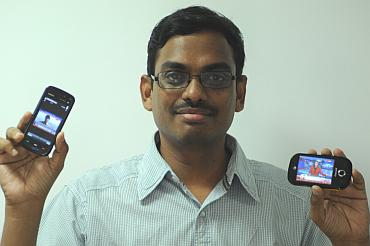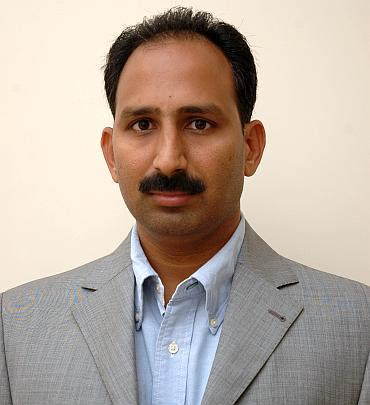
Did you enjoy watching the recently concluded IPL T20 2010 cricket tournament on your video-enabled mobile phone?
Are you currently enjoying the T20 World Cup playing out in the sunny Caribbean on your mobile all the way in India?
You have two start-up entrepreneurs -- Vamshi Krishna Reddy and B Surya Shive Shanker of Apalya Technologies (in Sanskrit Apalya means mobility) -- to thank!
They risked high-flying careers at US multinational companies to return to India in 2000 and had the guts to believe that mobile content business -- more so, video on-demand -- would offer huge opportunities.
These two entrepreneurs, who studied computer science at the same college in interior Maharashtra in 1994, and later travelled around the world on various career assignments, came back together and founded Apalya in 2008 -- nine years after they had first thought of starting a business around mobile phone content.
Today, Apalya makes and owns the technology that optimises high resolution video content, like live streaming of cricket matches, so that you can enjoy matches on your cell phones, anytime, anywhere, on the go. Apart from this revenue stream, they also earn money by aggregation of premium entertainment content from various sources and optimising them for mobile phones.
Prasanna D Zore spoke with co-founders Vamshi and Shive to discover the challenges they faced while starting their entrepreneurship. They also offer their reasons for starting a business on their own rather than working for top-notch multinational companies and why they are betting big time on the Indian Premier League (they are the official and exclusive worldwide mobile live streaming partner for IPLT20.com till 2012 and own India rights for streaming live T20 World Cup matches). Vamshi and Shive discuss their revenue model, the lessons they learnt and their dos and don'ts for budding entrepreneurs.

You did your BTech from a relatively unknown college in Pusad, a small town in northern Maharashtra. Didn't you feel insecure while studying at a small-town college about your job prospects?
Vamshi: While B N College was not a top-notch institute in 1994 it had the best facilities and infrastructure for studying computer science. Then information technology as a sector was just picking up. So there was more demand for IT graduates then there was supply.
But nobody doubted our skills or talents just because we did our BTech from an unknown university in interior Maharashtra while we landed up for interviews.
Shive: In 1994 there was a lot of demand for engineers with skills in embedded software and product development from Bangalore and Hyderabad. Also, our college has the best facilities for advanced unique systems and that put us at an advantage during interviews as we had the best technical resources at our disposal in our college.
Definitely, our college syllabus and infrastructure was on par with the best needs of the industry then.
Tell us about your college years and later your careers with top-notch MNCs?
Shive: We did our BTech in computer science from B N College of Engineering in Pusad, Amravati University in 1994. After that I started my career more on the product side in the telecom sector. From Wipro Systems in Hyderabad I moved to the US and from there came back to India in 1997. From 1997 to 2000 I worked with General Electric Transport Corporation on the locomotive controller software side. In 2000 I joined Nokia and started working on mobile operating systems.
Way back in 1999 we knew that the smartphone market would eventually evolve and offer a huge opportunity. And right from the year 2000 I have been involved with development of mobile operating system software on the Symbian (a proprietary operating system owned by Nokia) platform. Then I moved to Finland in 2003.
Vamshi: Both of us studied in the same college. But later I went to Hyderabad and taught in a couple of institutes before I got an opportunity to move to US in 1998. There I worked as a consultant in New York with different companies like Ernst & Young, AT&T. Later I got a chance to move to the Silicon Valley where I started working with Cisco primarily as a solutions architect on data warehousing and slowly grew into building databases. From 1999 to 2005 I involved myself in polishing my business development skills. Shive at that time was in Finland and we decided to come back to India and start doing something on our own.
How did Apalya Technologies happen?
Vamshi: When we came back to India I moved on to Cisco in India. But both of us were pretty much looking at the India growth story. The intent to start something on our own was there even before we came back to India. We sat down and thought: India has a huge market especially in the mobile space, but we need to find an opportunity that existed within this space. We spent almost four months brainstorming different business opportunities and collecting data from the market on potential areas within mobile space.
We even hired an MBA grad to work as an intern and do data research and analysis for us. Within the mobile space we looked at commerce, gaming, media and entertainment, wallpapers, education, and pure technology plays.
Shive: But after doing our geographical research as to what was working in the US, Japan and other markets we realised that mobile television would emerge as a huge opportunity in India. We also realised that demand for data will grow exponentially along with the demand for delivering videos on mobile phones. Right on cue we spent a lot of our resources on R&D and in developing our delivery platform and products in this space.

How does Apalya earn money?
Shive: We have deployed our video/TV on mobile solution (S?) across all operator networks. We work with the operators, content providers and provide our services in the form of subscription model to the end subscribers. Whatever fees the end subscriber pays is shared amongst Apalya, content providers and operators.
Usually our share in this split varies across operators and content providers depending on the partnerships we have. It can vary anywhere from 35 to 50 per cent in our favour. And for the last two years we have been growing at almost 300 per cent, which explains the growth potential in videos on mobile space.
We have the platform that powers the mobile video streaming. We knew that people would love to watch IPL on their mobile phones on the go. During IPL T20 2010, we offered services on 2G platform where a consumer bought a daily pack for Rs 10 and watched matches scheduled on a given day. We also had Rs 40 weekly pack. Or you could buy a season pack for Rs 150.
What kind of money did you invest in this venture?
Vamshi: When we started we invested close to a million dollars by borrowing from friends and family. Last September we raised $3 million from IDG Ventures and Qualcomm Ventures. And given the growth we are registering we are confident to break even by the end of March 2011.
Both of you had high-flying careers but yet you decided to abandon it all to become entrepreneurs. Why this risk?
Shive: I think it's not a question of risk. More than that it's about what you want to do in your life. One thing that I realised while working for these big companies was you are working for certain goals which might be very short-term from the delivery standpoint but may not align with your passion. So it was monotonous work day-after-day, fighting corporate battles and political battles in office than actually doing what we loved doing.
We also couldn't justify the gratitude we were earning while working for big companies. No matter how much you innovate and help companies earn big the value you earned out of it was not great. We thought of doing something that would create value for us and give us the satisfaction that we didn't derive at our workplaces.
This feeling of satisfying our talents and creating value has been our motivator.

What kind of growth do you see in India for on-demand mobile TV? How will it change once operators roll out their 3G services and how will you benefit out of this?
Vamshi: If you just look at the video segment, irrespective of the Internet or mobile, video is the primary driver of growth. And everyone is betting on on-demand video big time. Despite being a two-year-old start-up we have gained a lot of valuable experience understanding video, its delivery, understanding what products and services we can offer within our limits to the end consumers. Given these capabilities we have succeeded in having a subscriber base of 1.4 million on the 2G services itself out of which 25 per cent is our active subscriber base that pays for our services. These subscribers are our real revenue generators.
Shive: Now that 3G is happening we see a huge, huge potential. Already BSNL and MTNL (these government-owned companies have already rolled out their 3G services in Mumbai and Delhi) subscribers are enjoying 3G immensely. The consumption of videos on 2G networks is on an average 4 minutes per subscriber but on 3G networks it has gone up to 25 to 30 minutes.
Do you think beaming IPL matches live on mobile for the next three years will change your fortunes?
Shive: Yes we are betting big on the IPL. As per our research the demand for video content online has primarily been driven by sports events whether it be Olympics or the NBA (in the USA). Given that IPL is the biggest platform our vision is to make sure that every mobile subscriber -- given that India has a mobile subscriber base of 500 million -- get IPL in their hands. And if we can get even 10 per cent of this base then -- and with 3G likely to be rolled out in the next 6 months -- I think the opportunity is huge.
But not all mobile handsets In India are video-enabled?
Shive: The projections are that in the next two years there will be 50 million 3G handsets in India. Even if you take 10 per cent of this number as those who could watch mobile television then we are looking at five million subscribers to whom we can sell our subscriptions.
Where do you see Apalya five years from now?
Shive: Basically, our goal is to enable entertainment anywhere on the go. We want our consumers to consume video content on any device, at any time and anywhere in India. Our vision is to create that platform and ecosystem to provide such type of content.
What challenges did you face as a start-up company?
Vamshi: When you start a company there are not many people who are enthusiastic to join you. Attracting talent in 2008 was one of our biggest challenges. But there are always people, who may not be top-notch, but have the right kind of attitude to help your business grow and show willingness to join you. Just like the companies who hired us despite our college being in interior Maharashtra.
These guys may not crack the CAT or GMAT but they are smart. We went after those folks and convinced them to become a part of a revolution.
Shive: Also, not all the college graduates get hired during campus interviews. They may be talented but yet they don't find recruitment. The challenge is to find such students and give them an opportunity to excel and grow along with you.
Vamshi: The second challenge was to convince the operators about the attractiveness of our video content, our optimisation software and make them pitch it to their customers. Since both of us came from outside India it was difficult for us to build relationships with content providers as well as network operators.
What would be you dos and don'ts for young entrepreneurs?
Shive:
Don'ts